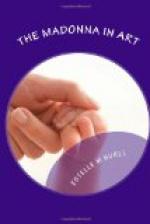Among others who were affected by the influence of Leonardo—and chief of the Lombards—was Luini. His pastoral Madonna has, however, little in common with the landscapes of his master, judging from the lovely example in the Brera. The group of figures is strikingly suggestive of Da Vinci, but the quiet, rural pasture in which the Virgin sits is Luini’s own. In the distance is a thick clump of trees, finely drawn in stem and branch. At one side is a shepherd’s hut with a flock of sheep grazing near. The child Jesus reaches from his mother’s lap to play with the lamb which the little St. John has brought, a motif similar to Raphael’s Madrid picture, and perhaps due, in both painters, to the example of Leonardo.
It is said by the learned that during the period of the Renaissance the love of nature received an immense impulse from the revival of the Latin poets, and that this impulse was felt most in the large cities. In the pictures noted, we have seen its effect in Florentine and Lombard art; that it was also felt in isolated places, we may see in some of Correggio’s work at Parma, at about the same time. Two, at least, of his Madonna pictures are as famous for their beautiful landscapes as for the rare grace and charm of their figures. These are the kneeling Madonna, of the Uffizi, and “La Zingarella,” at Naples. Both show a perfect adaptation of the surroundings to the spirit of the scene. In the first it is morning, and the gladness of Nature reflects the Mother’s rapturous joy in her awakening babe. A brilliant light floods the figures in the foreground and melts across the green slopes into the hazy distance of the sea-bound horizon. In the second it is twilight, and a calm stillness broods over all, as under the feathery palms the Mother bends, watchful, over her little one’s slumbers. Such were the revelations of Nature to the country-bred painter from the little town of Correggio.
Turning now to Venice for our last examples, we find that the love of natural scenery was remarkably strong in this city of water and sky, where the very absence of verdure may have created a homesick longing for the green fields. It was Venetian art which originated that form of pastoral Madonna known as the Santa Conversazione. This is usually a long, narrow picture, showing a group of sacred personages, against a landscape setting, centering about the Madonna and child. The composition has none of the formality of the enthroned Madonna. An underlying unity of purpose and action binds all the figures together in natural and harmonious relations.
The acknowledged leader of this style of composition—the inventor indeed, according to many—was Palma Vecchio. It is curious that of a painter whose works are so widely admired, almost nothing is known. Even the traditions which once lent color to his life have been shattered by the ruthless hand of the modern investigator. The span of his life extended from 1480 to 1528. Thus he came at the beginning of the century made glorious by Titian, and contributed not a little in his own way to its glory.




